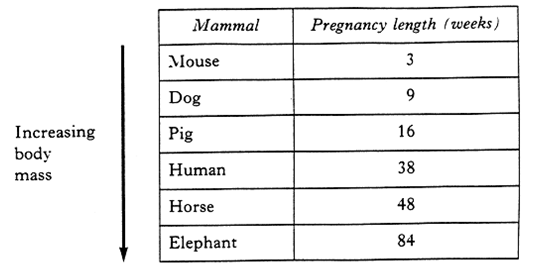|
Question 1. |
|
Look at the table showing the growth of a baby in the uterus. |
|
 |
| a) |
How many times larger was the baby at 40 weeks compared with 7 weeks? |
| b) |
Use the information to predict the size of the baby at 30 weeks of development. |
|
Question 2. |
|
The table shows the length of pregnancy for a variety of mammals. |
|
 |
| a) |
Present this information as a bar graph |
| b) |
What is happening to the length of the pregnancy as the body mass increases? |
| c) |
How many times longer is the pregnancy of the horse compared to that of the pig? |
|
Question 3. |
|
The diagram below shows some human cheek cells as they appear when viewed through a microscope. |
|
 |
|
The diameter of the field of view of the microscope is 120 micrometres. |
|
Calculate the average width of a human cheek cell. |
|
Question 4. |
|
A student carried out an investigation into the effect of temperature on the growth of yeast cells. The results are shown in the table below. |
|
 |
|
What change could the student make to make their experiment a fair test? |
|
|
| A |
Use the same number of yeast cells at the start |
| B |
Repeat the experiment |
| C |
Count the number of yeast cells after one hour |
| D |
Use a wider range of temperatures |
|
Question 5. |
|
The table below shows the results of an investigation into the effect of temperature on egg laying in adult red spider mites. |
|
 |
|
|
|
As the temperature increases, the average number of eggs laid per female per day |
| A |
increases |
| B |
decreases |
| C |
stays the same |
| D |
halves |

